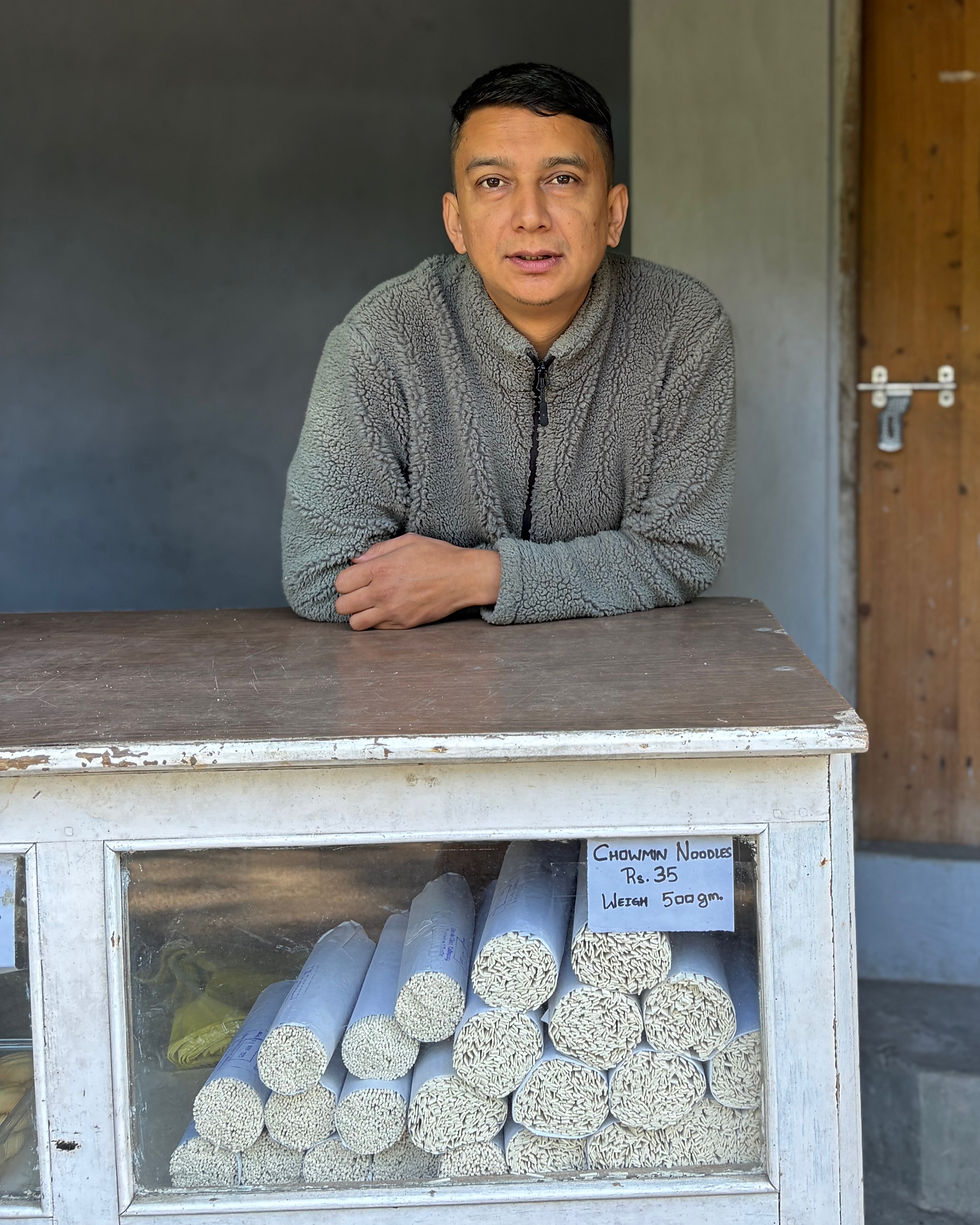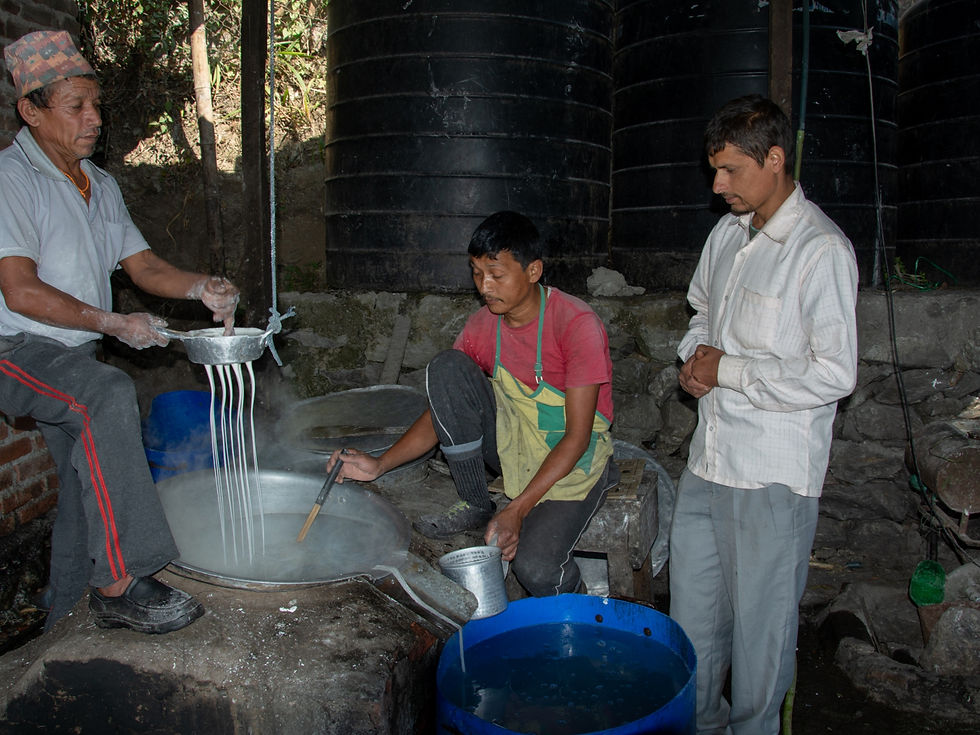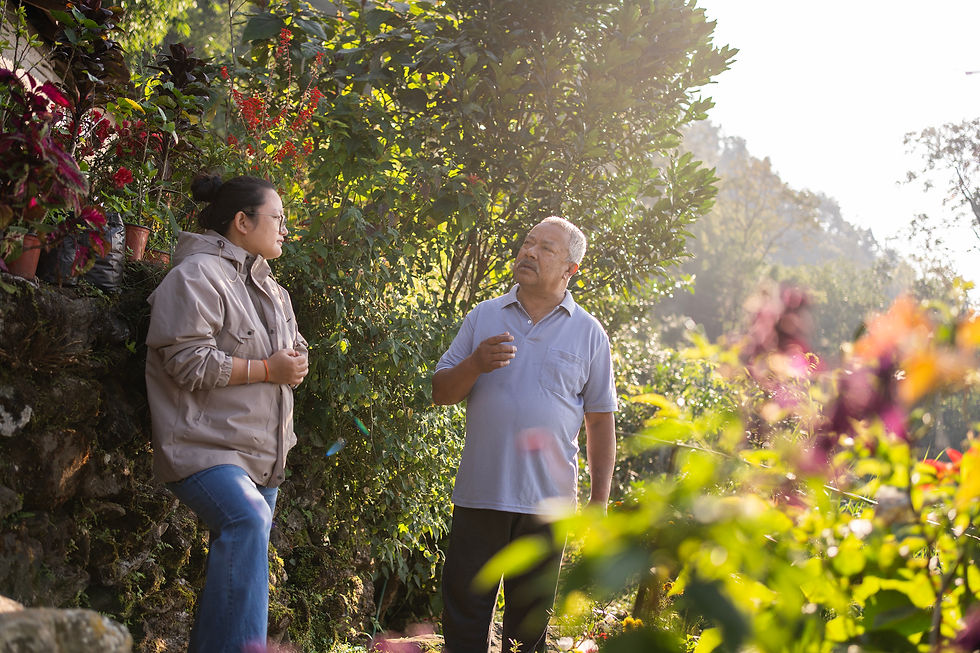The Dying Art of Phing and Thukpa Making in Kalimpong- A tale of four brothers, a vanishing craft, and the quiet grief of letting go
- Ishita Rai Dewan
- Nov 11
- 11 min read

The Chettri brothers’ story is a tangle of craft, survival, and stubborn pride.
There are four of them Gopal, Lalit, Yuvraj, and Akraj. Each learned Phing and Thukpa-making in a different way.
But to understand their story, you have to understand the town that shaped it.

Kalimpong wasn’t always the bustling little town we know today. Long ago, it was just a small hamlet, quiet and remote, until the British and the Bhutanese fought their war. When Bhutan lost the territory east of the Teesta, the British annexed it, linking Kalimpong to the Darjeeling district. What really changed everything, though, were the mountain passes Jelep La and Nathu La, offshoots of the ancient Silk Route. They connected India to Tibet, and Kalimpong sat right along the way. Traders came and went with their caravans of wool, fur, and grains. With them came new languages, new faces, and new flavors.
It was during this time that Tibetan and Chinese families began to settle here, setting up small shops, tea houses, and trading posts. Their presence quietly reshaped the town’s rhythm and taste. Tibetan culture, in particular, seeped deep into our soil, blending effortlessly with Lepcha, Nepali and Bhutanese traditions. Momo, Thukpa, and Phing became part of who we were, humble, hearty, handmade.
When Tibet fell in 1959, everything changed again. Monks, traders, and entire families crossed over, Tibetan and Chinese alike bringing with them monasteries, prayers, crafts, and recipes. Kalimpong became a sanctuary of both loss and new beginnings, where memories of the plateau mingled with the mist of the hills. It was in this mingling of cultures, in this quiet crossroads of histories, that the Chettri brothers found their craft Phing and Thukpa-making. What began as Tibetan tradition slowly became Kalimpong’s shared heritage, carried on by hands that learned through imitation, friendship, and faith.
When I first started writing this piece about the Chettri brothers, the eldest brother, Gopal Chettri still had his Phing manufacturing unit running. There was still a hum of life in that corner of Kalimpong. But as I finish these last lines, even that has gone quiet. The final factory has shut its doors. And with that, a chapter ends, not just for a family, but for an entire tradition.
We chefs often speak of legacy, the slow knowledge passed through burnt fingers, stained aprons, and quiet observation. In Kalimpong, Phing and Thukpa-making isn’t just a livelihood. It is a legacy, craft, a way of life. Something Kalimpong stands out of it.
For decades in the quiet pre-dawn hours of Kalimpong, when most of the town would still be wrapped in sleep, a handful of homes in Chisopani Village would already be alive with motion. The clang of grinding stones, the sift of starch through muslin cloth, and the hush of water settling into silence marked the beginning of another day. By 4 am, the Phing makers would already be at work. Not because they had to. Because they knew no other way. There were no machines. No shortcuts. Just starch, water, and an instinct honed over generations. Phing, the translucent, glassy noodle, requires patience you don’t learn in culinary school. You don’t make Phing, you become someone who knows when the starch has rested enough, who can read a bowl of paste with your fingers. It’s not work. It’s ritual.
And like many sacred things, it is now slipping away.
Water, the very foundation of Phing and Thukpa making, has become uncertain. Natural springs are drying. Taps cough instead of flowing. What was once freely available now comes with tension and scarcity.
Kalimpong’s crisp mountain weather, cool mornings, dry afternoons, and gentle sunlight, was once ideal for drying Phing. The Phing stretched across Tirpai Hill top, where the Chettri brothers had their drying unit, glistening under the sky like threads of glass. The temperature and air were just right, not too humid, not too harsh. A perfect climate that respected the slow drying process needed for the noodles to achieve their signature chew. Not just Phing it was also best suitable for incense sticks drying. This unique geography also made Kalimpong a natural trade hub. Its location and craftsmanship turned Phing into a sought-after product, quietly exported to Ladakh and South India, especially to Tibetan refugee camps and monasteries, where familiar food meant comfort. From this small hill town, bundles of carefully packed noodles travelled far crossing state lines and cultural boundaries.

The first time I went to meet Gopal Chettri, the eldest brother, it was early morning. The hills were wrapped in that soft mist that smells of damp wood and sleepy shops.
Somewhere up ahead, I could hear it, the slow rhythm of water being stirred.
When I reached the workshop, the air was misty with the running water. A dim bulb hung from a wire, casting long shadows across drums of mung bean pastes water. Gopal's staff at workshop looked up from his basin, his hands white with starch. I watched as he scooped the paste, poured it into a cloth sieve , and let the water drain out the starch water to ferment, cloudy, heavy which he then pooled in another container.


Gopal shook his head. “Phambi ko Pani,” he said, referring to the cloudy, starch-heavy liquid left behind, “was once as treasured as the noodles themselves.”
“Vendors, hawkers, and home cooks queued up at dawn with jerrycans and bottles walking almost 4,5km from town. By 5 a.m., the line would stretch around the block, and only the lucky ones got their share. It was gold in the right hands, the base for Phambi, that beloved spicy jelly laced with Dalle chutney.”

Gopal says "back in the early 2000s, we sold a packet of Authentic Phing for ₹18. Today, it’s down to ₹15. Meanwhile, the price of mung bean, firewood, kerosene oil, labor and everything else has gone up. Where’s the sense in that?"
And yet, it wasn’t just about selling Phing. It was about feeding a community.
Three dishes made from mung bean starch once defined our snacking soul. The most iconic? “Accha ko Lefing”world-famous in Kalimpong, or at least that’s how it felt to us. It wasn’t just a dish. It was a rite of passage. School feast day treat. Saturday outing ritual. I still remember walking down with friends, collecting coins, finding excuses just to sit there and slurp that cold, spicy soup. It was infamous, too, for being a secret hideout where boys and girls snuck off to smoke, flirt, or just feel like rebels away from watchful eyes. No bowls. No forks or spoons. Just a plastic packet, your two fingers, and pure joy. We’d pour the leftover soup straight into our mouths, wiping our faces with sleeves and laughter. Wah, what memory!
And the irony? The dishes made from the byproducts of Phing-making. Lefing and Phambi sometimes became more beloved than Phing itself. Now, even those are fading. The quality of Phing, Lefing, and Phambi sold at Haat bazaar and small stalls isn’t the same. Lefing has become Laphing, made not with mung bean starch, but refined wheat flour. The texture is wrong. The soul is missing.

Yes, some people are still making Phing in the hills. But the truth is it’s not the same. The ingredients have changed, the process has changed. Once the work of hands and patience, it now hums with the rhythm of electric motors. The taste has changed. People say, “It’s not like before.” Everyone talks about the difference in quality. But no one asks why. No one digs into the reasons. The weather, the humidity, the rising temperatures. Global warming is not just something happening in distant places. It’s here, subtle, quiet, but real. And it’s changing everything. The starch behaves differently. The drying isn’t uniform. The once-perfect Kalimpong sun now feels inconsistent, too strong some days, absent the next. And yet, no one connects the dots. We chalk it up to a bad batch.
Meanwhile, in the plains, factories churn out Thukpa that look the part but lack the soul. They cut corners, cheaper flour, rushed processes and sell shiny packets at throwaway prices. These industrial noodles flood the market, pushing artisans like the Chettri's into a race they never wanted to run. Even when they try to adapt better packaging, wider reach, they lose. Because good packaging costs money. And the market rarely rewards quality. It rewards convenience, volume, shine.
So they are stuck. Modernize and bleed. Stay traditional and disappear.
By the time I met Lalit, the second brother, his unit was already gone. We sat in his kitchen over breakfast, steam curling up from our cups, as he looked back on those years. “It was Phing that paid for my children’s education,” he said softly. But over time, it just wasn’t enough to keep going. Most Thukpa and Phing makers he knew had stopped seeing their craft as a full-time livelihood. What once built homes was now just a side gig. Lalit, the second of the Chettri brothers, had eventually walked away too. “Too much effort. Too little return,” he told me. There was no bitterness in his voice, only exhaustion.
Back in the ’80s, Phing and Thukpa were mostly Tibetan and Bhutanese delicacies, treasured in a few kitchens, rarely made beyond those circles. But Kalimpong was a crossroads. Whispers of tradition often crossed borders and hands.
His Holiness the Dalai Lama’s brother Late Gyalo Thondup established Thukpa factory in Kalimpong 1966-1967. It was a quiet but influential operation, a sign of how deeply Tibetan food-ways had rooted themselves into this hill town. Gopal and Lalit Chettri first learned the craft of Phing as young workers in a factory run by a Tibetan owner near Sanjay Saw Mill, one of Kalimpong’s oldest units. In 1986, Gopal decided to strike out on his own, opening one of the first Nepali-run Phing factories in town. Lalit chose a different path at first, moving to Sikkim to work, while their brother Yuvraj, inspired by Gopal’s success, learned the craft and opened his own unit.
Yuvraj had picked up noodle-making after befriending a skilled factory worker, bringing that knowledge home. He passed it on to his son, who continues the family tradition today, running a modest unit focused on Thukpa, less temperamental, less workers, less water-dependent, but still handcrafted with care. Yet over time, challenges mounted: water grew scarce, labor costs climbed, and Yuvraj eventually closed his factory after twenty years, turning entirely to Thukpa.

I’ve stood inside Bijay Chettri’s old workshop, a dim room, barely touched by sunlight. He still rolls and dries his Thukpa the way he was taught by his father Yuvraj Chettri, the third brother. His hands don’t falter, but his voice carries a quiet sadness. “Youngsters don’t want to do this anymore,” he told me. Can we blame them? The work is hard. The hours brutal. Call centers and city jobs promise more money and fewer blisters. And so, what was once taught from father to son now waits in silence for a student who may never come.

Lalit eventually returned from Sikkim in the late 1990s, drawn by the sight of his brothers’ thriving factories. He opened his own unit in 1997 and over time, the brothers’ efforts merged, a family of artisans keeping the tradition alive. Akraj, the quiet fourth brother, never started a factory of his own but became the steady hand behind the scenes, learning from his siblings and helping wherever needed, keeping the units afloat during their heyday.
But dreams, like dough, stretch only so far. Lalit’s unit is long gone, the first in the family to fall to the changing times in 2017. Gopal’s unit, Kalimpong’s last traditional Phing-making factory, has also closed its doors. The next generation has moved on to other paths, leaving behind mung beans, water, and early mornings. The craft that once tied four lives together now exists only in memory.
Three brothers. One quiet helper in the wings. Four lives devoted to tradition. And now, one lost inheritance.

Served at weddings and mourning ceremonies, Phing eventually became a kitchen staple. Its subtle taste made it easy to pair with any vegetable or meat, showcasing its culinary adaptability. Over time, its versatility inspired locals to create a variety of dishes from salads to soups making Phing an integral part of the inter-cultural culinary fabric of Kalimpong-Darjeeling hills and Sikkim. It was and remains a dish cherished by all. I first learned to cook and enjoy Phing from my Tibetan friends, and I suspect most people make it much the same way, with only small variations and personal touches along the way. Just five or ten years ago, Phing was the only glass noodle we knew.
It was ours. Local. Handcrafted. Deeply woven into our food stories and kitchens.
But today, that’s changed. Supermarket shelves are lined with imported Thai glass noodles, packaged with glossy labels and exotic fonts. Somewhere along the way, we stopped reaching for what was made in our own backyard. We forgot the texture of mung bean noodles dried in the Kalimpong sun. We traded memory for marketing.

This isn’t just about Thukpa and Phing. It’s about people. The ones who rose before dawn, ground mung beans by hand. Who trusted their fingers more than timers. Who passed down knowledge through calloused palms, not cookbooks. It’s about food that carried place, identity, and patience. Food that was never meant to compete with convenience but to stand for something far more nourishing. This isn’t just a change in taste. It’s a slow unraveling of memory. What remains is not a business plan or revival strategy. Just the fading smell of mung bean starch in a sun-warmed room. The echo of water being stirred. The laughter over Lefing eaten from plastic packets. The jerrycans once filled with cloudy water that made Phambi.

Is this the slow death of Phing, much like Kalimpong’s Cheese & Lollipop, a local treasure that once represented and gave Kalimpong a unique identity, proudly celebrated by residents and tourists alike? Will they soon exist only as stories and memories?
Author : Ishita Rai Dewan

"For me, food has always been an extensive and heartfelt affair and it all started at home. In my family, food isn’t just something we eat; it’s our favorite subject, our way of connecting, and our language of love. My father was a chef, and from an early age, I was surrounded by a cooking-learning environment shaped by my parents and grandparents. (You must definitely try my grandpa’s Chicken Curry Rice!) My torrid love affair with cooking and baking began when I was just four years old, and it’s been a lifelong passion ever since."
After completing my college education in Kolkata, I decided to bypass the usual campus recruitment route and carve my own path. In 2014, I started ISHEE’Z KITCHEN ( a food delivery and takeaway venture that I ran single-handedly for four years. What began as a one-woman army kitchen soon grew into one of Kolkata’s favorite soul food spots. My specialties included the melt-in-the-mouth Pork Chop Hawaii, a range of homemade sausages, and my signature customizable one-pot meals.
In late 2018, I took on a new challenge as Assistant General Manager – Operations & Business Development (Fresh Food Category) at Shell Technology Centre, Bengaluru, where I oversaw Deli Café, Select, and The Tuck Shop.
I returned home to Kalimpong in 2020 to continue and expand my culinary journey. That same year, I was honored to win the MasterChef Competition organized by Rockvale Management College, Kalimpong.
In 2021, I relaunched my brand as Isheezkitchen in Kalimpong, and in 2022, I co-founded Cloud9 Authentic Nepali Restaurant, celebrating local flavors and culinary traditions.
Most recently, I’ve taken on an exciting new challenge showcasing Himalayan Nepali cuisine across India through curated pop-ups that tell the story of our mountains, ingredients, and heritage. My pop-ups have been hosted at Taj Chia Kutir Resort & Spa, Darjeeling, Glenburn Penthouse, Kolkata, and Pullman, New Delhi.

















Such a wonderful and important essay! The Chettri family are truly custodians of our culinary traditions. This essay highlights the intricacies of craft, culture, tradition, and changing times through Phing and Thukpa. Foods deeply beloved throughout our region but regretfully disappearing.